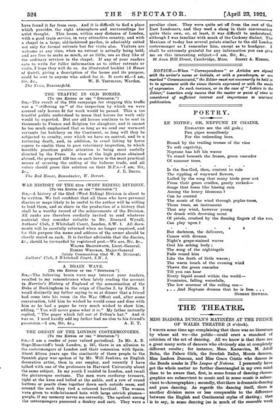TILE THEATRE.
MISS ISADORA DUNCAN'S MATINgES AT THE PRINCE OF WALES THEATRE (3 o'clock).
I WROTE some time ago complaining that there was no literature by whose aid we—the public—could erect a standard of criticism of the art of dancing. All we know is that there are a great many sorts of dancers who obviously aim at completely different results ; for instance, Mme. Karsavina, M. Adolf Bolm, the Palace Girls, the Swedish Ballet, Morris dancers, Miss Isadore, Duncan, and Miss Grace Cristie who dances in the Benda masks in The League of Notions. I personally have got the whole matter no further disentangled in my own mind than to be aware that, first, in some forms of dancing choreo- graphies are subservient to music and in some musio is subser- vient to choreographies ; secondly, that there is dramatic dancing and pure dancing. As regards the dancing itself, there is another division more or less comparable to the difference between the English and Continental styles of skating ; that is to say, in some dancing (as in much of the ensemble work of M. Jacques Dalcroze's pupils and some of Mr. Boughton's ballets where the dancera play the part'of scenery) the dancing of individuals is secondary to the patterns which are made by the positions of the dancers in relation to each other. In another school, hie that of Miss Isadore Duncan, dancing is an entirely individual matter, with a single dancer on the stage, and often very little movement at all.
Most of Miss Isadore, Duncan's dancing falls for primary category into the same class as that of M. Jacques Dalcroze's pupils ; that is to say, the dancing is secondary to the music : it is an interpretation. On Tuesday week she danced a pro- gramme entirely consisting of Chopin's works, admirably played by Mr. Walter Rummel. It was the first time that I had seen her, and, speaking as one entirely ignorant of music, I thought she had made rather an unfortunate selection of her music. The " etude " in E major, for instance, seems to me to be like a wide landscape with high-piled clouds sending shadows across it and a wind ruffling the trees, and not in the least like a woman, however beautiful, standing in amorphous classical drapery close to a grand piano. In the first part of the programme Miss Duncan scarcely moved at all, coming on to the stage with reluctant, dragging footsteps and standing perfectly still, with gestures of her arms and head by way of expression. These gestures were apparently intended to be interpretative, as they did not seem to bear any rhythmic relation to the music. In the " Funeral March " suite she seemed to me to point the moral far too plainly and to tell the story of grief, of the aban- donment of the grave, and then of a happy resurrection only too clearly. In the miming all the subtlety of the music was lost. Much more attractive was her dancing in the " Three Polonaises," which she treated as a sort of spring song and, crowned with roses, danced with a great deal of rhythm and gaiety. This, it seems to me, is much Miss Duncan's best work ; here she is delightful. She was, of course, one of the pioneers of the so-called classical dancing which did so much to revive public interest in what was in England virtually a lost art.
TARN.



































 Previous page
Previous page